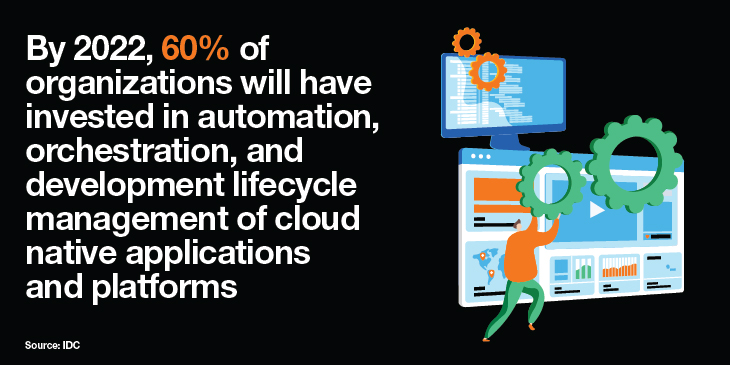With employees working from home and more business interactions happening digitally, over 50% of respondents to a recent report said their cloud usage will be much higher than they planned due to the pandemic. With 93% stating that they have a multicloud strategy, cloud native is the obvious next destination. Cloud-native computing is cloud agnostic, for example, and enables organizations to scale up and down according to required capacity. Organizations also have more control over the applications they build. Instead of having one large structure, cloud native allows for smaller structures that are much simpler to manage and make changes.
Taking a cloud-native approach requires a radical rethink
According to IDC, by 2022, 60% of organizations will have invested in automation, orchestration and development life cycle management of cloud-native applications and platforms. However, organizations are finding that going cloud native is a very different world to operate in than traditional software development. Cloud native requires planning and a significant enterprise re-think. It needs enterprises to be open minded and experimental. It is, above all, a continuous process that requires commitment and vision.

Traditionally, development teams work in silos. Developed applications are immutable, highly manual and often follow the waterfall release principle where they can only be scaled up gradually. They are typically operating system dependent, which can make migration risky. In addition, traditional infrastructure is built on a long-term development process, which means new release rollouts can be very slow.
In a cloud-native scenario, everything is accelerated. According to 451 Research, the adoption of cloud native is “driven by the speed, automation, efficiency, scalability and portability it can bring to the modern enterprise.” 451 Research also sees cloud native as supportive and complementary to several other neighboring trends, including artificial intelligence (AI), the Internet of Things (IoT) workloads and edge computing.
Leveraging the power of cloud
Deploying an application in the cloud originally designed to run in a traditional data center as part of a so called “lift and shift” approach isn’t adequate in today’s increasingly digitized world, especially where speed to market has become a key differentiator.
The quicker an enterprise can conceive, create and roll out a solution or service, the more value it has. Cloud native’s flexibility and scalability make it way easier to experiment in the cloud. This supports the “fail fast, learn fast” methodology.
Designing applications knowing that failure might be the outcome seems an odd concept to many enterprises. But it is imperative that enterprises understand this ethos before setting out on the cloud-native journey. Failing fast and continuously improving should be central to any enterprise’s transformation effort. Without a mindset that doesn’t embrace fail fast, energy and motivation can quickly wane.
This methodology works because cloud-native development is rooted in small, frequent releases of new software functionality or new services instead of the traditional waterfall model, where a considerable amount of development work has a triumphant finale in a major software release. Features such as microservices and containerization that hold the key to cloud-native development are quick and easy to change. Development cycles can be ratcheted from months to weeks.
Enabling the true value of cloud
Going cloud native is the next step in the cloud journey. But it is a journey that will require energy and commitment, both in financial terms and human resources. Many enterprises find this a considerable challenge. According to a survey by the Cloud Native Computing Foundation (CNCF), 43% of enterprises flagged cultural change within development teams as one of the top issues in switching to these new development methods. Many are also finding training a challenge.
Cloud native is an evolving vista with new tools and practices being continually developed and added. Adopting cloud native principles and DevOps, which encourages collaboration between the development and operations teams, requires cross-functional ways of working that address business needs. These may require mentoring and cultural change training.
The other significant factor that enterprises need to change their outlook on is costs. If enterprises start to add up the costs of cloud native before realizing the business outcomes, they will not get the agility, speed and flexibility they were anticipating. While centralized processes obviously need to be in place to track spend, it should not be sealed off at a certain point. This can put the brakes on the development cycle.
This is where FinOps comes in. According to the FinOps Foundation, FinOps “increases the business value of cloud by bringing together technology, business and financial professionals with a new set of practices and standards around cloud financial management.” FinOps is invaluable in understanding the costs associated with software and spotting opportunities where they can be optimized.
The giant leap to cloud native
To support new services and applications, cloud native is the next logical step in an enterprise’s cloud transformation. Adopting these new technologies requires a marked change in mindset to work.
Going cloud native begins with a complete re-think of traditional IT structures and processes that provide the very foundations of productivity. Often, enterprises take the first steps to cloud native only to fall over due to an idea fixed in legacy application environments.
A cloud-native business reacts differently to market demands. Before any enterprise embarks on a cloud-native journey, it must accept that there will be disruption and change. Enterprises that can grasp the concept of rapid experimentation will reap the many benefits of cloud native.
Find out how you can make multicloud work for your enterprise by optimizing performance, enhancing the user experience and boosting the bottom line. Download our e-book: All Things Cloud: building a future-proofed multicloud strategy.